Email: ijhsa@housingscience.org | WhatsApp & WeChat +44-07410426381
On this page
- Research article
- Volume 45, Issue 2
- Pages: 28
- -36
- Open Access
- Download
Exploration of the Integration and Application of the Modern New Chinese Style Interior Design
By: Yang Wu1
1Academy of Fine Arts, Nanjing Xiaozhuang College, Jiangsu, Nanjing 210000, China.
- Published: 30/06/2024
Abstract
Artificial intelligence (AI) is increasingly used in the Internet of Things (IoT), and allows physical devices in the real world to connect with the Internet. Now, with the emergence of resource conservation, energy efficient utilization and social harmony, the rapid realization of the new Internet of Things combined with artificial intelligence technology also puts forward higher requirements for the sustainable design of modern interior environment designers. This paper mainly studies the distributed positioning algorithm based on relative position information in 3D environment, provides the latest algorithm model for the application of new communication and sensor technology in indoor environment design, and proposes sufficient conditions. The algorithm uses Laplace matrix to skillfully transform the position information in local coordinate system, and gives the process of calculating the weight of the directed edge. Then, the algorithm is simulated using Matlab. The simulation starts from whether there is noise, and verifies the robustness of the distributed algorithm by introducing noise interference. Simulation results show that the algorithm can achieve high positioning accuracy, and verify that noise interference has no effect on the effectiveness of the algorithm.
- Keywords: communication technology, sensing technology, indoor environment design, indoor mapping
1. Introduction
But the environmental problems caused by social industrialization are also increasingly prominent [1]. In traditional architecture, the quality of indoor environment design is directly related, which virtually increases the importance of ensuring the quality of indoor environment. Poor indoor environment may also induce some diseases, such as skin diseases such as xerosis and pruritus, respiratory diseases such as asthma and dry cough, itchy eyes, headache, difficulty in concentration and other neurological problems [2,3].
First of all, various environmental parameters required for intelligent control of the indoor environment design system are mainly obtained through the indoor environment monitoring system, such as indoor temperature, moderation, light intensity, to control other intelligent appliances to adjust the indoor environment; Secondly, both the indoor environment monitoring system and the indoor environment design system are the products of the continuous development of the Internet of things technology, it has important practical significance for accessing more intelligent electrical appliances and providing more comprehensive and comprehensive indoor environment design services in the future; Finally, the deployment of a complete set of indoor environment design system requires high costs. Most ordinary families can hardly afford the economic level, and they need to transform the existing housing to meet the deployment requirements of the indoor environment design system [4,5]. The indoor environment monitoring system is relatively simple, and does not require too much economic expenditure. In addition, the use of wireless means does not require too much transformation of the house wiring [6].
In addition, in today’s increasingly perfect sustainable design in the building field, the indoor environment design is developing in a positive direction due to its influence. However, the sustainable indoor environment design is not as good as the building system specifications, and there are still many problems: improper materials, improper ventilation and lighting, low indoor comfort, air safety problems, noise problems, excessive energy consumption for refrigeration and heating, etc [7,8]. The sustainable interior environment design theory is based on the internal environment theory of green buildings, but its own characteristics are concentrated and it is an independent research direction. At present, domestic attention and research efforts are insufficient [9]. In particular, due to the large flow of people in the indoor environment, more energy is needed for the comfortable coexistence of indoor personnel, which requires more water, light and electricity resources [10]. How to make sustainable indoor environment design reasonable and evidence-based has become an important responsibility of researchers and designers. Secondly, the regionality and many conditions limit the diversity of indoor environment design practices. Designers should adjust measures to local conditions, utilize local natural resources and existing conditions to maximize the use of sustainable elements, reduce energy consumption and pollution, and improve the economic, cultural and social value of the indoor environment [11].
If we want to discuss the use of new communication and sensing technologies in indoor environment design, we need to clarify the main features of indoor environment design, namely comprehensiveness and multifunction [12]. More and more indoor environments of commercial buildings show the characteristics of complete functions and comprehensive supporting facilities. Large commercial spaces have the functions of office, shopping, finance, catering, living, leisure, entertainment, and are equipped with complete functional facilities. The distribution of internal spaces combines these functions to create a good indoor environment for internal personnel. Even small commercial spaces are also rich and colorful [13]. Taking the catering space in the commercial space as an example, in addition to the dining area, kitchen, staff office and rest area, the comprehensive restaurant also has exhibition area, performance area, bar, to guide customers to diversify their consumption. In general, the modern indoor environment revolves around commodities, commodity demanders and commodity managers. For commodities, the indoor space has the functions of display, sale and storage; For customers and consumers who have demand for goods, the indoor environment has shopping and leisure functions, and more importantly, it can meet the spiritual and cultural needs of consumers; For commodity managers and commercial administrators, the indoor environment has the functions of office and operation. These combine to form a good atmosphere of diversified and multi-functional indoor environment [14].
To sum up, indoor environment design based on new communication and sensing technology has become an integral part of urban construction. Its forms are ever-changing, the space is full of vitality, and it has positive social benefits. It is an important place for people to carry out public activities and create a comfortable working, entertainment and leisure environment for people.
2. Related works
In the process of interior design, interior architectural drawing belongs to the field of map construction, and is proposed with map construction. The interior architectural drawing was proposed in the mid-1980s and has been developed for more than 30 years, more and more scholars at home and abroad use radio frequency and acoustic measurements for indoor mapping. In reference [15], the author discussed node location tracking and indoor mapping in the absence of infrastructure in combination with IEEE802.15.4a wireless ultra wideband (IR-UWB) link. This paper provides a multi hypothesis tracking filter for TOA measurement with errors to locate nodes and determine room size. Literature [16] proposed a rectangular room and the relative position of wireless communication equipment in the room. Both this document and document [17] use pulse radio ultra wideband link technology and single reflection mode of indoor reflective wall. Considering the secondary reflection of the reflection wall, a self positioning and indoor mapping technology suitable for pulse radio operation is introduced[18]. Literature [19] introduces the application of ultra wideband communication positioning system in building three-dimensional maps, systematically analyzes the problem structure, and proves the feasibility of the mapping system in the paper. Literature [20] uses Multipath Detection Radar (MER) to build indoor maps, which requires a lot of measurements to create scatter maps. Reference [21] uses sound delay measurement to carry out indoor construction drawings, and these documents distribute the received echo to the reflective wall through detailed search.
To sum up, as new communication and sensing technology has been a new topic in the past 20 to 30 years, and the breadth of research fields, involving the material quality and spiritual enjoyment of interior space design, involving many fields such as economy, politics, culture, and ecological environment, determines that the academic community is still lacking in in-depth research on sustainability, which is also the significance of this study.
3. Indoor Environment Design Model of Communication and Sensing Technology
The position of free nodes is unknown, that is, it needs to be determined by positioning algorithm. Generally, free nodes are randomly arranged. As shown in Figure 1, the free node is connected with the anchor node through direct connection or multi hop, so that the position information of the anchor node can be obtained directly or indirectly. At the same time, the distance, angle, topology and other data can be obtained through ranging, angle measurement and other measurement methods.

This model is based on the location algorithm of new communication and sensor technology, and its main purpose is to determine the location of nodes. The closer the estimated position is to the actual position, the algorithm used is considered successful and effective, which is also called positioning accuracy. The number of nodes should also be considered for positioning accuracy. The average value of positioning error is calculated as follows:
\[\label{e1} E=\frac{1}{N} \sum_{i=1}^N \sqrt{\left(x_i-x_i^{\prime}\right)+\left(y_i-y_i^{\prime}\right)^2}\tag{1}\]
However, in the actual environment of indoor design, there will be a lot of noise in data measurement and data transmission, so the location algorithm should have strong robustness, that is, it should be feasible in the case of noise. Some measures can even be taken to ensure the positioning accuracy of the algorithm. At the same time, when the whole network changes the number of nodes or changes the location of nodes, the feasibility of the algorithm will not be affected. The following equation is usually used to measure the energy consumption required in the positioning process:
\[\label{e2} Average_{}^{}Energy_{}^{}Setup = \frac{1}{N}\sum\nolimits_{i = 1}^N {(initial_{}^{}Energ{y_i} – after_{}^{}Energ{y_i})}\tag{2}\]
Then, a sensor network composed of 8 nodes is given, of which 4 are anchor nodes (labeled 1,2,3,4) and 4 are free nodes (randomly arranged). The whole environment consists of 7 walls, marked a to g, where the equation of the wall is:
\[\label{e3} W=\left(\begin{array}{l} a: y-3=0 \\ b: 19 x-5 y-574=0 \\ c: 15 x+23 y-1046=0 \\ d: 7 x-4 y+57=0 \\ e: 13 x+9 y-157=0 \\ f: z-6=0 \\ g: 38 x-10 y-127 z+3932=0 \end{array}\right.\tag{3}\]
At present, many indoor mapping applications based on new communication systems and sensors use single node to detect indoor environmental information, which has the disadvantages of slow speed and incomplete environmental information. However, multi node indoor mapping is fast and accurate, so how to use multiple nodes to coordinate with each other for indoor mapping, how to formulate corresponding coordination schemes, and how to select corresponding communication methods. The structure diagram of the multi node coordination building environment is shown in Figure 2.

In some real scenes of indoor environment design, the algorithm designed needs to rely on angle information to achieve, and angle information is generally obtained using AOA measurement method. The measurement principle of AOA is to use the node with ultrasonic receiver or antenna matrix to sense the direction of arrival of the transmitted signal, so as to calculate the relative angle between the transmitting node and the receiving node. With this measurement method, distance information and angle information can be obtained simultaneously. As shown in Figure 3, Node 1 and Node 2 are receiving nodes, equipped with ultrasonic receivers, and U is transmitting node. Node 1 and Node 2 sense the angle of transmitted signal through the receiver \(\alpha\) and \(\beta\).

The indoor environment design monitoring terminal node is located at the front end of the system and connected with sensors. Each terminal node is equivalent to a sensor node, which is distributed in the room where data collection is required to collect environmental data. Its circuit consists of ZigBee module, data acquisition module and external power supply. The function of the data acquisition module is to collect the environmental data of different indoor areas, and then package the data and send it to the coordinator through the ZigBee wireless network. The external power supply mainly provides the ZigBee module with appropriate voltage. The hardware structure of the terminal node is shown in Figure 4.
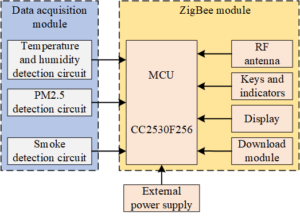
In addition, the design of ZigBee module mainly includes the core board design and the bottom board design of the module. The main control chip of ZigBee core plate is CC2530 from TI Company, and the main peripheral circuit is composed of RF circuit, crystal oscillator circuit and power decoupling circuit. The design of ZigBee backplane module mainly includes the design of power module, key module, indicator light and download module, as shown in Figure 5.

The function description of the pin is shown in Table 1.
| Pin Name | Pin | Pin type | Describe |
|---|---|---|---|
| AVDD1 | 28 | Power supply (analog) | M=1 |
| AVDD2 | 27 | Power supply (analog) | M=1 |
| AVDD3 | 24 | Power supply (analog) | M=1 |
| AVDD4 | 29 | Power supply (analog) | M=0 |
| AVDD5 | 21 | Power supply (analog) | M=0 |
| AVDD6 | 31 | Power supply (analog) | M=0 |
| DCOPL | 40 | Power supply (digital) | Decoupling of 18V digital power supply without external circuit supply |
| DVDD1 | 39 | Power supply (digital) | M=0 |
| DVDD2 | 10 | Power supply (digital) | M=0 |
The ADC mainly consists of three configurable independent channels, one reference voltage generator and one analog multiplexer. ADC conversion results can be written into DMA direct memory access or directly read from ADC registration access. Table 2 shows the technical parameters of CC2530F256.
| Name | Minimum value | Typical value | Maximum | Company |
|---|---|---|---|---|
| Supply voltage | 2.0 | 3.1 | 3.8 | V |
| Emission current | 28 | 27.8 | 45 | mA |
| Receiving current | 26 | 28 | 30 | mA |
| Working frequency | 2.407 | – | 2.487 | GHz |
| Transmitting power | 3.6 | 4.1 | 4.3 | mW |
| Wireless transmission rate | – | – | 250 | kbps |
| Series Rate | 2400 | 9600 | 115200 | kps |
| Working temperature | -40 | – | 80 | ℃ |
| Size | – | 2.5*2.6 | – | cm |
4. Methods
A. Interactive experience and interface analysis of indoor environment design
Taking common shopping plazas as an example, according to the form of top interface, it can be generally divided into transparent top interface and closed top interface. In the specific design process, in addition to introducing the technical means of interactive experience in a large area, we should also comprehensively consider the influence factors such as structure, materials, light color, and pay attention to its overall effect. Transparent roof interfaces are common in private indoor atriums in shopping. While introducing natural light to reduce energy consumption, they meet consumers’ experience needs of returning to nature through landscape gardening. Moreover, with the development of glass technology, in the near future, roof interfaces full of large size display glass will become a featured environmental art design field with highly visual impact effects of shopping space self-expression and multi-functional interaction with consumers, as Figure 6.

In fact, in the interior environment design, different space forms can be formed according to different sensors and various styles of enclosure, which also forms different space atmosphere. The main composition of space refers to the relationship between people, objects and the environment. In addition, space form is the basis of the entire theater space environment and the display of space image. The handling methods of various functional spaces in the theater are different. It is necessary to analyze the characteristics of different spaces, as well as the requirements of environmental atmosphere, the appropriate materials, light environment and color style, and the handling of space interfaces by facilities, equipment, construction technology, which will attach certain characteristics to the space and enhance the integrity of the space. The functional area combination mode of the model is shown in Figure 7.
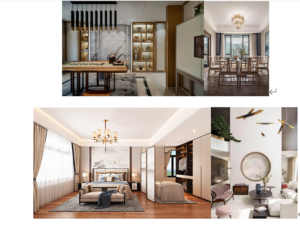
B. Experimental data and simulation analysis
In this section, numerical simulation experiments will be designed based on relative position information in the 3D model of indoor environment design. There are two groups of simulations designed here. In Simulation 1, assume that the entire application environment is noise free, so as to observe whether the final convergence position of the algorithm is consistent with the real position. In the second simulation, measurement noise will be added to determine whether the algorithm is convergent in case of disturbance. Consider a wireless sensor network with m=4 anchor nodes and n=10 free nodes. All nodes are randomly arranged in three-dimensional space. Among them, anchor nodes are marked as 1, …, 4, and free nodes are marked as 5, …, 14. The measurement topology is shown in Figure 11. A directed edge in the figure represents unidirectional measurement and bidirectional communication between corresponding nodes. At the same time, because the nodes are randomly arranged, the nodes in wireless sensor networks meet the assumptions. Figure 8 is the sensor network meets the two locatable conditions mentioned in the theorem. The next two groups of simulations in this section are based on this wireless network.
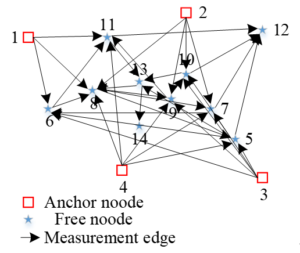
5. Experiment
In the absence of noise interference, the function curve of error rate eer (t) of indoor environment design coordinate position estimation with iteration steps t is shown in Figure 9, the error rate of position estimation has approached zero. In the subsequent iteration process, the estimated position will remain unchanged and equal to the real position. The corresponding position information of each iteration step is shown in Table 3. From this figure, it can also be seen that the estimated positions of all free nodes are finally equal to the real positions.

| Parameter | Condition | Min | Type | Max | Company |
|---|---|---|---|---|---|
| Resolution (hum) | 25℃ | – | 2 | 4 | %RH |
| Resolution (hum) | 0-50℃ | – | 6 | – | Bit |
| Repeatability (hum) | 0℃ | – | \(\pm\)2 | – | %RH |
| Accuracy (hum) | – | – | \(\pm\)4 | – | %RH |
| Accuracy (hum) | – | – | – | \(\pm\)5 | %RH |
| Range (hum) | – | 10 | – | 60 | %RH |
| Range (hum) | 25℃ | 10 | – | 70 | %RH |
| Range (hum) | 50℃ | 10 | – | 60 | %RH |
| Range range (tem) | – | 0 | – | 50 | ℃ |
| Response time (tem) | 1/e (63%) | 6 | – | 30 | S |
| Range range (tem) | – | 0 | – | 50 | ℃ |
| Response time (tem) | 1/e (63%) | 6 | – | 30 | S |
According to the working principle of DHT11, VCC chooses to connect 3.3V voltage. DATA is used to connect the pins of CC250F256 chip. The operation results of indoor environment design model circuit experiment are shown in Table 4, Table 5 and Table 6. After the communication process starts, the host will send a start signal to DHT11 through the DATA line. After receiving the signal, DHT11 will return a response signal. After receiving the response signal, the host will start to receive 40bit temperature and humidity data.
| Indoor air perception | 10 | 1 | 0.1 | 0.01 |
|---|---|---|---|---|
| Air quality status | Sick building | Health building | Urban outdoor air | Outdoor air in mountain area |
| Air supply temperature of air conditioner (℃) | 26 | 28 | 30 |
|---|---|---|---|
| Air conditioning energy consumption (kW · h) | 1.47 | 1.21 | 1.68 |
| Date | August 1, 2015 | August 2, 2015 |
|---|---|---|
| Comfort (%) | 86 | 95 |
| Energy consumption (kW · h) | 19.4 | 14.4 |
Even the indoor environment design with communication technology and sensors as the main physical source, its shading, indoor wind speed and air conditioning supply temperature improving the indoor thermal environment and energy conservation. The sun shading prevents most of the direct sunlight from entering the room, and the indoor temperature drops significantly, reducing the load of the air conditioner. At the same time, with appropriate indoor wind speed, it not only further, but also improves the comfortable temperature required by people, increases the temperature setting value of the air conditioner. Not only that, the energy consumption of air conditioners is different when the air supply temperature of different air conditioners reaches the required indoor comfortable temperature of 29 ℃. Although 26 ℃, 28 ℃ and 30 ℃ all meet the comfort requirements, 28 ℃ is the most energy-saving when the air supply temperature is 28 ℃. A comfortable indoor thermal environment does have a significant impact on people’s health, comfort and work efficiency. But today, with the increasing shortage of global energy, we should be less blind and more aware of energy conservation in the pursuit of comfort.
In addition, this collaborative positioning and interior mapping problem can be transformed into a simple three-dimensional positioning problem through virtual node transformation. The converted sensor network includes 15 nodes, of which 7 are virtual nodes. The measurement topology is shown in Figure 9. Figure 10 only shows the measurement relationship between nodes and does not represent the true coordinates of nodes. The solid arrows in the figure represent LOS measurement between nodes, and the dotted arrows represent SBR measurement between nodes.
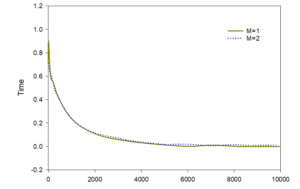
6. Design Effect
Figure 11 case for the new Chinese style, the living room space as a whole without partition design, the maximum degree of preservation of the permeability of the region; the main and secondary bedrooms in the same style, simple and elegant, simple and charming interior decorations; dining, guest kitchen integrated design, to meet the owners of the living life of the flexible space needs; functionality to meet the current living habits, in the design of the Chinese elements decorated with the design of the classical and fashionable perfect conjunction; The overall style pursues a home experience rich in classical flavor, so that the traditional elements in modern home decoration design is appropriately reflected.
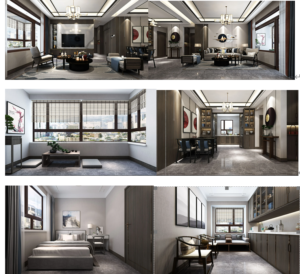
7. Conclusion
The paper hopes that the introduction of foreign research results and the practical application of design can help designers to better carry out sustainable indoor environment design, the new design can follow the principles of sustainable design and the six design methods proposed by the author, and the old indoor environment will also be transformed into a sustainable commercial space. On the basis of meeting the functional and aesthetic requirements. This paper mainly studies the location and indoor mapping algorithm of distributed wireless sensor networks based on relative location information. Based on the existing literature. At the same time, in terms of convergence, the distributed location algorithm can quickly converge to the true value, and the location success rate is high. In terms of robustness, even if there is noise in the environment, the algorithm will eventually converge. In terms of computation, the algorithm does not involve complex computation, which provides a great possibility for hardware implementation.
References
- Kunhoth J, Karkar A, Al-Maadeed S, Al-Ali A. Indoor positioning and wayfinding systems: a survey. Human-centric Computing and Information Sciences. 2020 Dec;10:1-41.
- Viswanathan H, Mogensen PE. Communications in the 6G era. IEEE access. 2020 Mar 18;8:57063-74.
- You W, Li F, Liao L, Huang M. Data fusion of UWB and IMU based on unscented Kalman filter for indoor localization of quadrotor UAV. Ieee Access. 2020 Apr 2;8:64971-81.
- Li S, Li Q. Research on the Path and Countermeasures for the Construction of Bases for the Integration of Production and Education in Chinese Universities. Int. Core J. Eng. 2020;6:160-6.
- Feng D, Wang C, He C, Zhuang Y, Xia XG. Kalman-filter-based integration of IMU and UWB for high-accuracy indoor positioning and navigation. IEEE Internet of Things Journal. 2020 Jan 9;7(4):3133-46.
- Spachos P, Plataniotis KN. BLE beacons for indoor positioning at an interactive IoT-based smart museum. IEEE Systems Journal. 2020 Feb 18;14(3):3483-93.
- Nair V, Olmschenk G, Seiple WH, Zhu Z. ASSIST: Evaluating the usability and performance of an indoor navigation assistant for blind and visually impaired people. Assistive Technology. 2022 May 4;34(3):289-99.
- Zhou J, Liu Q, Jiang Q, Ren W, Lam KM, Zhang W. Underwater camera: Improving visual perception via adaptive dark pixel prior and color correction. International Journal of Computer Vision. 2023 Aug 31:1-9.
- Zhou J, Li B, Zhang D, Yuan J, Zhang W, Cai Z, Shi J. UGIF-Net: An efficient fully guided information flow network for underwater image enhancement. IEEE Transactions on Geoscience and Remote Sensing. 2023 Jul 10.
- Ali J, Shan G, Gul N, Roh BH. An Intelligent Blockchain-based Secure Link Failure Recovery Framework for Software-defined Internet-of-Things. Journal of Grid Computing. 2023 Dec;21(4):57.
- Ali J, Jhaveri RH, Alswailim M, Roh BH. ESCALB: An effective slave controller allocation-based load balancing scheme for multi-domain SDN-enabled-IoT networks. Journal of King Saud University-Computer and Information Sciences. 2023 Jun 1;35(6):101566.
- Dong Q, Liu X. Optimization Practice of University Innovation and Entrepreneurship Education Based on the Perspective of OBE. Journal of Combinatorial Mathematics and Combinatorial Computing.;118:181-9.
- Xu J. Optimizing English Education in the Information Era: A Multimodal Approach Based on BOPPPS Teaching Model. Journal of Combinatorial Mathematics and Combinatorial Computing.;118:33-48.
- Ren X, Ahmed I, Liu R. Study of topological behavior of some computer related graphs. Journal of Combinatorial Mathematics and Combinatorial Computing. 2023;117:3-14.
- Shan WL, Jin RM, Ding XY. Chinese decorative color based on improved alexnet in interior decoration design. Mathematical Problems in Engineering. 2022;2022(1):2358905.
- Wu S. Application of Chinese traditional elements in furniture design based on wireless communication and artificial intelligence decision. Wireless Communications and Mobile Computing. 2022;2022(1):7113621.
- Zhang G. Application analysis of traditional cultural elements in the environmental art design of coastal cities. Journal of Coastal Research. 2020 Jun 4;115(SI):27-30.
- Wang YH, Ajovalasit M. Involving cultural sensitivity in the design process: a design toolkit for Chinese cultural products. International Journal of Art \& Design Education. 2020 Aug;39(3):565-84.
- Gu Y, Wang Y, Li J. [Retracted] Model of the Integration of the Building Interior with the Natural Environment Based on Nanomaterials and IM Pei’s Design Concept. Journal of Nanomaterials. 2022;2022(1):6373574.
- Zhang R, Zhao Y, Kong J, Cheng C, Liu X, Zhang C. Intelligent recognition method of decorative openwork windows with sustainable application for Suzhou traditional private gardens in China. Sustainability. 2021 Jul 28;13(15):8439.
- Ma B, Dong Y, Liu H, Cao Z. Soft multimedia assisted new energy productive landscape design based on environmental analysis and edge-driven artificial intelligence. Soft Computing. 2022 Dec;26(23):12957-67.